Transceiver


|
Since 1994 Jim Garland W8ZR has maintained an owners list of know existing Hallicrafter FPM-200 transceivers. The list contains 31 rigs! It has often been reported that the production quantities of this rig was not much more than thirty units. I guess we will never know the exact production numbers. It appears that the last three digits of the serial numbers does follow a sequencial order and based on W8ZR's list the lowest know to exist was 521 and the highest at 582 which provides us with 62 radios This assumes no holes. The FPM-200 described in these pages has the lower three digits of 533. Even with a somewhat higher total production in the early 1960's this still places the FPM-200 in the league of "rare" amateur equipment. Even below the production numbers for other pieces like the Hallicrafters SX-88, Collins 32S3A or the very expensive Collins KW1. The FPM-200 introduced in 1959 was still advertised in electronic retailer catalogs as late as 1963/64. The lack of sales success for the FPM-200 was not in its qualitity, but in its cost. It sold for $2650 in my 1963 Allied catalog or about half the average yearly workers wage at the time! As you read through these pages and view the pictures I'm sure you will agree that Hallicrafters placed a great deal of time and money into the design and manufacturing of this transceiver. It was light years ahead of the competition in design innovation and the use of new technologies. While Collins already had the KWM-1 transceiver in production and later released the KWM-2 during the time the FPM-200 was being produced, both of those very fine rigs used no or very limited use of solid-state devices. In contrast the FPM-200 was totally solid-state with the exception of the RF Driver, power amplifier and associated regulator tubes needed to provide voltage to the prior. This same design philosophy was used by many ham equipment manufacturers, both domestic and foreign, into the late 1970's. Quality component selection was used throughout. This is exemplified by the fact that after forty plus years, to the best of my knowledge, no components have been or have required replacement in this radio! You'll see more about this as you read through the rest of this site. As an introduction to the FPM-200 below are the published specifications from Hallicrafters. To highlight some of the outstanding features: Dual PTO (Permeability Tuned Oscillator), which versus the typical variable capacitor variable frequency oscillator (VFO), provides not only the flexibility and convenience of variable frequency, but also accurate calibration and high stability. As a side note, of the ham equipment manufacturers Collins (developer), R.L. Drake and Central Electronics (100V and 200V) were three major companies to us the PTO for control of the operating frequency. PTO's were more expensive and difficult to build, but until the introduction of frequency synthesis nothing could come close to accuracy and stability! Out of all the aforementioned manufacturers Hallicrafters was the only transceiver to utalize two separate PTO's. Operates from 12VDC. This made the FPM-200 a perfect choice for mobile operation. Inside the rig is a DC-DC converter that supplies all the high voltage required for the power amplifier tubes. No big external rear mounting power supplies required. What you see is what you get..... Respectable power output of 100 watts. Relatively Light weight for the time. Only 24.5 lbs.
|